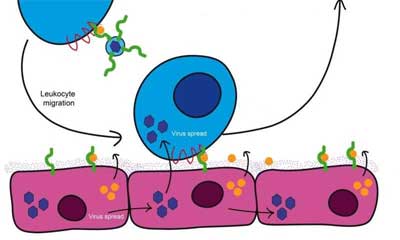- Home
- Editorial
- News
- Practice Guidelines
- Anesthesiology Guidelines
- Cancer Guidelines
- Cardiac Sciences Guidelines
- Critical Care Guidelines
- Dentistry Guidelines
- Dermatology Guidelines
- Diabetes and Endo Guidelines
- Diagnostics Guidelines
- ENT Guidelines
- Featured Practice Guidelines
- Gastroenterology Guidelines
- Geriatrics Guidelines
- Medicine Guidelines
- Nephrology Guidelines
- Neurosciences Guidelines
- Obs and Gynae Guidelines
- Ophthalmology Guidelines
- Orthopaedics Guidelines
- Paediatrics Guidelines
- Psychiatry Guidelines
- Pulmonology Guidelines
- Radiology Guidelines
- Surgery Guidelines
- Urology Guidelines
How Chickepox Spreads through the body

The virus that causes chickenpox -- varicella zoster virus (VZV) -- possesses a protein that could enhance its ability to hijack white blood cells and spread throughout the body, according to new research published in PLOS Pathogens.
The findings, presented by Víctor González-Motos of Hannover Medical School, Germany, and colleagues, may provide new insight into the poorly understood mechanism by which VZV spreads after initial infection in the respiratory tract.
VZV causes chickenpox in children and can reactivate later in life to cause shingles. After infecting the respiratory tract, the virus hijacks the immune system's white blood cells, using them to spread in the body -- including to the skin to cause chickenpox.
To better understand this process, the researchers investigated whether VZV influences the function of chemokines, small immune system proteins that attract white blood cells to sites of infection and guide their movement within the body.
The scientists focused on a VZV protein known as glycoprotein C, since previous research suggested it may play an important role in the infection cycle. In the lab, they performed chemotaxis experiments and found that the addition of glycoprotein C enhances the ability of chemokines to attract white blood cells, including white blood cells from the tonsils, which are a major target of VZV during initial infection.
Further experiments uncovered the molecular details of the interaction between glycoprotein C and chemokines. The researchers also showed that VZV viral particles that had been genetically engineered to remove glycoprotein C had a reduced ability to enhance chemokine attraction of white blood cells, indicating the importance of glycoprotein C for this process.
Overall, these results suggest that glycoprotein C may interact with chemokines to attract more white blood cells to the site of VZV infection, where the virus can hijack the white blood cells to spread to other parts of the body. Further research is needed to investigate whether this hypothesis holds up in human tissue.
For more details click on link : Víctor González-Motos, Carina Jürgens, Birgit Ritter, Kai A. Kropp, Verónica Durán, Olav Larsen, Anne Binz, Werner J. D. Ouwendijk, Tihana Lenac Rovis, Stipan Jonjic, Georges M. G. M. Verjans, Beate Sodeik, Thomas Krey, Rudolf Bauerfeind, Thomas F. Schulz, Benedikt B. Kaufer, Ulrich Kalinke, Amanda E. I. Proudfoot, Mette M. Rosenkilde, Abel Viejo-Borbolla. Varicella zoster virus glycoprotein C increases chemokine-mediated leukocyte migration. PLOS Pathogens, 2017; 13 (5): e1006346 DOI: 10.1371/journal.ppat.1006346

Disclaimer: This site is primarily intended for healthcare professionals. Any content/information on this website does not replace the advice of medical and/or health professionals and should not be construed as medical/diagnostic advice/endorsement or prescription. Use of this site is subject to our terms of use, privacy policy, advertisement policy. © 2020 Minerva Medical Treatment Pvt Ltd